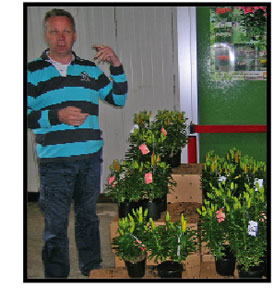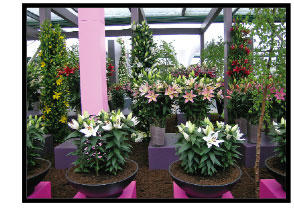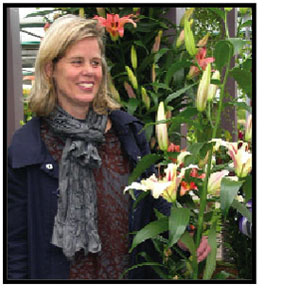7/15/2010
Trip Report: Lily Craze
Ellen C. Wells
The Dutch lily world was abuzz with activity in May, eagerly preparing for their annual Lily Parade, Mother’s Day weekend and the first-ever Lilytopia Festival across the pond at Longwood Gardens in Pennsylvania. Thanks to an exclusive tour organized by the International Flower Bulb Centre,
GrowerTalks went behind the scenes to see how they made it all happen.
Zabo Plants
Considering the mountain of work the next few days and weeks presented him, Frits Kneppers of lily hybridizer and exporter Zabo Plant Holland ushered our small band of lilyphiles into their facilities with trademark graceful Dutch demeanor and orders for coffee all around. He was eager to tell us about their newest lily—the rose lily—and chat about Zabo Plant’s role in bringing a lily festival to the U

.S.
Zabo is the company behind the Lily Looks line of pot lilies, which, according to Frits, is changing the way this crop is sold in the U.S. Lily Looks is really the first attempt at a comprehensive marketing campaign with POP for a potted lily line—as garden plants in garden centers and as plantable pot plants for supermarkets sales.
Zabo Plant will use the same marketing tactics for the rose lily Belonica, a double oriental cut flower with mild fragrance and no pollen. In the U.S., Belonica will be introduced primarily through supermarkets via a dozen large growers; roughly 80% of the stems will be available at the supers and 20% on the open market.
With most lily bunches shipped as tight buds for easier transport, how’s a supermarket shopper to know about Belonica’s doubled surprise inside? That’s where the marketing materials come in. Posters will draw the eye from afar, and a life-sized, realistic 2-D tag will show what appears when the bud opens. And, while our group didn’t see the Belonica in the flesh, the new lily made its U.S. debut less than two weeks later on an episode of “The Martha Stewart Show.”
Frits and Zabo Plant were also knee deep in plans for the inaugural Lilytopia, held at Longwood Gardens in Pennsylvania at the end of May. In fact, they had just conducted a trial run of shipping 1,500 lily stems to see how their staff could handle the process. What was remarkable, said Frits, was the degree of cooperation taking place among Dutch lily companies to ensure Lilytopia would be a success. Open to all lily breeders, each jumped on board to give their product a boost abroad.
 Vletter & Den Haan
Vletter & Den Haan
We stopped in at lily hybridizer Vletter & Den Haan on a day when they were cutting lilies in preparation for the Lily Parade at the world-famous gardens of Keukenhof, near Amsterdam (by the way, it’s no parade; it’s a floral exhibition). Nico Vletter explained that the company breeds their own varieties, then grows and sells them on their own for several years to build and/or gauge their acceptance on the market. Then other lily growers buy the license and materials for specific lily cultivars, giving them the right to grow and propagate those varieties. They pay V&DH royalties for that right. Breeders’ rights eventually expire in 30 years. By the way, V&DH’s best-known variety is Casablanca, the standard in clear white lilies.
From crossing to the intro’s sale to growers, the process, Nico explained, takes about 10 years. With 100,000-plus seedlings from a year’s hybridization program, just 20 to 30 of that batch may ultimately be introduced. And from that number, growers may like just 10. It’s a crapshoot, but with the speed of fashion and trends, it’s one that just may pay off. They focus on clear colors and in all color groups at all times—one never knows when a color gap will arise, and if you have the right color ready in the wings, all the better. And they are now breeding to meet growers’ cool-growing demands, too.
 J.A. & J. Moerman
J.A. & J. Moerman
Jaap Moerman does a big business selling his 10 to 12 exclusive lily varieties to the Tesco grocery chain in England. He admits he grows perhaps less well-known varieties, but he grows quality, and can sell them as premium cuts to the British grocery chain. Even though he has that direct relationship with Tesco—to whom he sells upwards of 75% of his product—Jaap still sends roughly 25% of the crop through the Dutch auction, FloraHolland. Why not just send the entire crop to Tesco? Having a presence at the auction, Jaap says, is an important way to maintain their reputation by showing consistently high-quality product —and maintain a strong price for his product.
Moerman produces about 2 million stems at their Dutch facility, but they are also producing twice that at their 6-year-old, 6-hectare facility in Tanzania. Jaap says there are about 10 to 12 horticultural companies in Tanzania now, but most of them are cuttings facilities. Interesting, because of the sociopolitical situation of the area, buyers of his Tanzanian product demand MPS and Fair Plants Fair Flowers certification. No one, especially a large grocery chain, would dare buy product without such assurances.
Paauw Lilies: Aautomation is Aawsome!
Paauw Lilies is one of the leading lily producers—and it may have something to do with their automated facilities, which is simply amazing. If you’re a greenhouse tech geek, you’ll definitely get your kicks from this:
www.youtube.com/growertalks#p/a/u/0/icJMLW5rGaU
Wetering Potlilium
Peter van de Wetering and Wetering Potlilium are growers of pot lilies and producers of the bulbs, as well. On the day we visited, their pot lily “factory” was buzzing along as typical: potting, benching, spacing and racking up of finished product, all while the thousands of plants—and particularly the Lily Looks line—grew inch by inch.
Peter, a savvy marketer, is searching out new avenues for his company’s lilies. Last year they tried pot lilies for the Christmas market, and did well through the Dutch garden retail chain Intratuin. Of the colors offered (red, white and pink), pink surprisingly was the best selling. What they need to do this year, Peter said back in May, is get on the chain’s spec list for the next holiday season. In addition, they’re also testing out new retail concepts that would make pot lily purchases more convenient and top of mind for the home gardener.
Hilverda de Boer
While the lily world prepared for the afternoon Lily Parade at Keukenhof Gardens, we visited exporter Hilverda de Boer. Thursdays—even the one before Mother’s Day—are slow in the flower-exporting world, since everything should already be on the road to its final retail destinations for weekend sales.
Marco de Groot, their U.S. salesman, explained that the company’s differentiator among other flower exporters is they way they pack. All packing isn’t the same, and packing preferences change from country to country—they are sure to pay attention to those details.
Flower preferences are different across continents, as well. European consumers seek out lilies that have tighter buds so the flowers last longer in the home. U.S. purchasers, on the other hand, are more spur-of-the-moment and prefer open flowers they can enjoy immediately.
 Lilies on Parade
Lilies on Parade
The world-famous Keukenhof, open for just eight weeks each year, is host to the Lily Parade exhibition, which is open to all Keukenhof visitors. An awards presentation—the lily world equivalent to the Academy Awards—is the exhibit’s official opening and is attended by everyone in the lily world.
Many of exhibits were designed

by Dorien van den Berg, a natural styling and concept developer for the floral trade. With several high-end Middle Eastern weddings under her belt (using hundreds of thousands of dollars worth of floral products), Dorien is Keukenhof’s top designer.
Dorien also was engaged to design the floral displays at Lilytopia, held at Longwood Gardens May 21-31.
GT
Want to see Longwood’s Lilytopia? Take a guided tour of the displays with Chris Beytes and Dorien van den Berg.
www.youtube.com/growertalks#p/a/u/0/afJmfqLi7tc